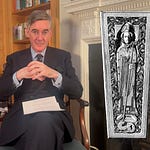This is a bonus article for all my subscribers - I hope that you will find it interesting.
The Bank of England, the epicentre of decline management that is once again failing the nation, has control of the design of banknotes. This is an important task, as notes reflect the creditworthiness of the nation and the stability of its currency. Trying to make banknotes modern or, worse still, woke, is a pointless activity. It shows an organisation that is too stupid to know what its job involves, that is too well funded, as it clearly employs people who do not have enough to do, and that is ignorant of its own and the nation's history.
Since Britain left the gold standard, the currency has been a ‘fiat’ currency. Fiat is the Latin word for ‘let there be’ as in ‘fiat lux’, the first words of direct speech in the Vulgate where God said “Let there be light”.
In the same way, central banks, with the connivance of governments, say ‘let there be cash’. This makes the statement “I promise to pay the bearer on demand”, a fiction, possibly even a lie. Up until 1914, if a note holder went to the Bank of England, or indeed a local bank, with a ten pound note, he could ask for, and would receive, ten gold sovereigns in return. Each sovereign was worth a single pound, so the promise to pay the bearer was as good as gold.
Now, all that would be handed over is a new note of no intrinsic value. Fiat currency has allowed governments to print money, this was done on a massive scale during the global financial crisis and again during covid. The temptation to do it is always there, because printing money has no immediate cost, as opposed to raising tax revenues or borrowing.
It has been done in various ways for centuries. The Song Dynasty (960-1279) issued paper money in the early 11th century, which eventually lost all its value. During the Hundred Years War, the French kings regularly took in old coins and reissued them with a lower level of precious metal but the same face value, so that it could keep the excess to pay its bills. Coins still have a milled edge because it prevents them from being clipped with little bits taken off the edge of a coin. However, doing this is the same as printing money, for the end result is that each individual currency unit has a slightly lower value in terms of its purchasing power.
The cumulative effect of this is that since 1914, when easy convertibility stopped, a pound now buys less than a single penny's worth of goods. In other words, over 99% of sterling's value has been lost. To put it another way, if a person changed his note for coins in 1914 and kept them for his children or grandchildren, each coin would still have a face value of a pound, but is now worth about £575 in its weight of gold.
This has happened because fiat currencies are always inflationary. Astonishingly, from 1661 to 1914, the purchasing power of a golden one pound was slightly higher at the end date than at the beginning. Although it fluctuated during this period, it always seemed to return to equilibrium.
The relevance of this to redesigning the coinage is that as fiat currencies are basically fake, every effort must be made to maintain the fiction that they have some value. That is why the US dollar has hardly, other than through the addition of new security features, changed since 1928. There are proposals to redesign the US dollar, but as they were very much favoured by the Democrats, it is likely that Donald Trump will abandon them.
Meanwhile, the UK has suffered from endless tinkering, partly as a response to the collapse in value because of inflation, but also because if you have people whose job it is to redesign notes, that is what they will do.
What is needed is continuity and stability, the illusion of value. Throughout the history of money, governments have wanted to show that their currency is worth something. That is why monarchs have had their heads on their coins, a practice that is believed to have started with Alexander the Great, who died in 323 BC.
This has always been seen as a means of conveying permanence. The Queen's image was only put on banknotes in 1960, just as inflation was really beginning to eat into the value of the pound. In those days, the bank understood symbolism, and the Queen's picture helped provide a link back to the historic strength of the pound, as did the notable figures from history, the great warriors, among other figures of worldwide renown.
Notes that have no real worth need to impress to maintain the fiction of value; this requires authoritative designs, but also continuity. The constant revolution at the Bank of England undermines confidence in the value of money, and confidence is its only value. Moving to the woke and the boring risks making people realise that paper currency is intrinsically worthless, and that way lies inflation.
This is why it matters. It is not just annoying that the Bank of England wants to put woke or dull items on banknotes to make them more like the dreadful and ugly Euro. Redesigning and making notes look less authoritative risks destroying the value that is in them, and is therefore economically risky as well as culturally barbarous.
You can now earn rewards by referring friends. For instance, if you can encourage three friends to subscribe, you will receive a month’s paid subscription. For more details please see the Leaderboard page.
Your comments would be most welcome. Please click the button to join the conversation. However, please note that comments should relate to the article in hand, and please be civil to other people commenting. Thank you.












